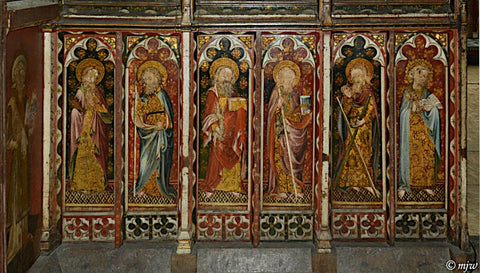
An altar frontal being made in our workroom, using our Black & Purple 'Gothic' silk damask.
This Lent we’re taking some time to reflect on our vestments and the incredible work that goes into their craftsmanship. We are also delving deeper into our company history as we celebrate our 150th anniversary: the company was founded in 1874 by the three leading figures of the Gothic Revival movement, G. F. Bodley, George Gilbert Scott Jr., and Thomas Garner.
With purple being the liturgical colour of the season, we thought we’d look a little closer at one of our favourite exclusive colourways: Royal Purple. Made in pure silks, these fabrics are eminently popular for Lenten vestments on account of the deep shade of purple dye we use, made for us in Sudbury, England.
This specific shade of purple has greater significance than simply its aesthetic quality.
Why do we use purple at Lent?
Historically, the rich hues of purple were a sign of royalty, being one of the most expensive dyes to produce, particularly in the Roman Empire of Jesus’ time.
Before the crucifixion, Herod’s soldiers mockingly placed a purple or scarlet robe on Jesus and sent him back to Pilate. After the scourging ordeal, members of Pilate’s praetorian guard dressed Jesus again in a purple robe, and placed a crown on thorns on his head. These gestures, used to ridicule Jesus, also embed purple as a significant colour in the image of His sacrifice. Purple not only signifies Jesus’s status as the King of Kings, but reminds us of the suffering He endured for the sake of humanity.

Cope hood from our archive depicting a hand embroidered Crown of Thorns on our Royal Purple 'Gothic' silk damask.
Over the 40 days of Lent, as we draw closer to our remembrance of the Passion, purple serves to remind us of what Jesus endured for the sins of mankind. It is also a visual call to the self-reflection, repentance and penance asked of us this season.
Watts' Royal Purple
Our Royal Purple silks include our ‘Gothic’ and ‘Holbein’ patterns, both designed by G. F. Bodley. The richness of the purple makes them ideal choices for Lenten vestments.


‘Holbein’ draws on further royal inspiration: the pattern was inspired by Charles de Brun’s tapestry The Baptism of Louis XIV. Hidden within the foliage that make up our ‘Holbein’, you’ll find several fleur de lys, the royal insignia of the French monarchy.
Our ‘Gothic’ is perhaps our most recognisable and enduring pattern, having been used for the vestments of British coronation ceremonies, as well as some of the most beautiful commissions in our history. Bodley found inspiration for the pattern in the Ranworth Rood Screen at the Church of St Helen in Norfolk, UK, specifically in the pattern depicting Saint Andrew. We’re unsure where this liturgical pattern originated before then, but this connection to Saint Andrew and his sacrifice imbues the fabric with a rich ecclesiastical history dating back to the Gothic age, for which Bodley had a great passion.

Detail from the Ranworth Rood Screen, depicting Saint Andrew on the right.
Today our Royal Purple silks feature in our bespoke vestment commissions, which are fully handmade in our showroom in Westminster. We are proud of the expertise that goes into this craft, being one of the only remaining companies committed to making beautiful vestments entirely by hand. Each piece contains part of the story of our 150-year history and of centuries of liturgical art.
Browse our full range of exclusive liturgical fabrics here.

Full Gothic High Mass set in Royal Purple & Black 'Gothic' silk damask.
